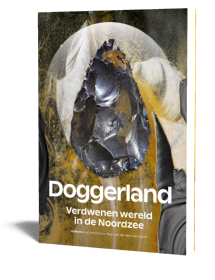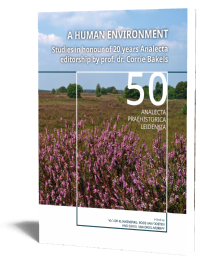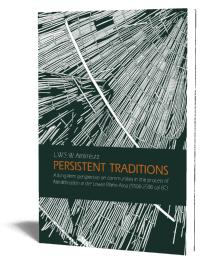Resurfacing the submerged past
Prehistoric archaeology and landscapes of the Flevoland Polders, the Netherlands
Edited by Hans Peeters, Laura Kooistra, Daan Raemaekers, Bjørn Smit & Karen Waugh † | 2021
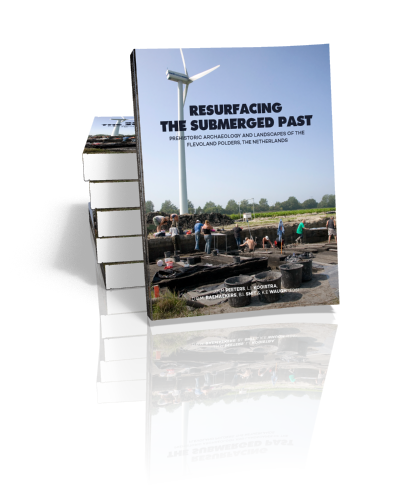
Resurfacing the submerged past
Prehistoric archaeology and landscapes of the Flevoland Polders, the Netherlands
Edited by Hans Peeters, Laura Kooistra, Daan Raemaekers, Bjørn Smit & Karen Waugh † | 2021
Paperback ISBN: 9789464260380 | Hardback ISBN: 9789464260397 | Imprint: Sidestone Press | Format: 210x280mm | 284 pp. | Language: English | 30 illus. (bw) | 150 illus. (fc) | Keywords: prehistory; mesolithic; neolithic; palaeolandscapes; Swifterbant Culture; Funnel Beaker Culture; heritage management; hunter-gatherers; early farmers; sea-level rise; wetland archaeology | download cover
Read online 384 times
- Digital & Online access
-
Buy via Sidestone (EU & UK)
-
Buy via our Distributors (WORLD)
For non-EU or UK destinations you can buy our books via our international distributors. Although prices may vary this will ensure speedy delivery and reduction in shipping costs or import tax. But you can also order with us directly via the module above.
UK international distributor
USA international distributor
-
Bookinfo
Paperback ISBN: 9789464260380 | Hardback ISBN: 9789464260397 | Imprint: Sidestone Press | Format: 210x280mm | 284 pp. | Language: English | 30 illus. (bw) | 150 illus. (fc) | Keywords: prehistory; mesolithic; neolithic; palaeolandscapes; Swifterbant Culture; Funnel Beaker Culture; heritage management; hunter-gatherers; early farmers; sea-level rise; wetland archaeology | download cover
Read online 384 times

We will plant a tree for each order containing a paperback or hardback book via OneTreePlanted.org.
The Netherlands are internationally renowned for the archaeology of its wetland environments. The reclamation of the Flevoland Polders in the early half of the 20th century not only exposed hundreds of shipwrecks, but also remnants of prehistoric landscapes and traces of human occupation dating to Mesolithic and Neolithic times. Ultimately, this led to the ‘discovery’ of the Swifterbant Culture in the 1960s-1970s, and which was initially seen as a Dutch equivalent of the Ertebølle Culture.
Archaeological investigations conducted by the University of Groningen, and later also the University of Amsterdam, delivered important new data on the nature of the Swifterbant Culture. It became key in the discussion about the adoption of crop cultivation and animal husbandry by hunter-gatherers living in wetland environments. Also, the Swifterbant Culture became central in the debate on the meaning of archaeologically defined ‘cultures’, questioning relationships between social interaction and material culture. With the increase of urbanisation and infrastructural works, alongside changes in the Dutch Monuments Act, dozens of small and large-scale development-led investigations got initiated at the turn of the century.
One project involved the construction of the Hanzelijn railway, crossing one of the polders from West to East. Archaeologists became aware that much of what was known – and unknown – about the prehistoric past of the Flevoland Polders, was not easily accessible. It was therefore decided to bring together, as much as possible, all the information from the many scattered sources, and make it accessible to professionals, both inside and outside the Netherlands. The result is this book, which presents an overview of the most important sites and data, and what these learn us about the nature of the archaeological record, landscape change, prehistoric subsistence, ritual behaviour, as well as socio-cultural developments during the Mesolithic and Neolithic.
Previously considered an impossibility, ‘fossilised’ fields, discovered at Swifterbant, demonstrate crop cultivation in wetland environments in an early stage of the Neolithic. In fact, the prehistory of the Flevoland Polders is tightly connected to the dynamic nature of the extended wetlands that characterised the landscape since the end of the last glacial. Although often regarded as the ‘margin’ of cultural dynamics in the past, we can now see that the Flevoland Polders were right in the centre of fundamental long-term changes in human existence in NW Europe.
Chapter 1 Introduction of the Hanzelijn Archaeological Project (K. E. Waugh (Ɨ), W. Hessing & J. Flamman)
1.1 Organisation
1.2 The archaeological project
1.3 Knowledge Development Program Archaeology Hanzelijn 2012-2020
1.4 Some retrospective remarks
Chapter 2 The cradle of the Swifterbant culture: 50 years of archaeological investigations in the province of Flevoland (D.C.M Raemaekers & J.H.M. Peeters)
2.1 Introduction
2.2 History of the polders
2.3 Research traditions in the polder
2.4 Research topics and approaches
2.5 The positioning of the Swifterbant Culture
2.6 Archaeology and the public
2.7 Conclusions
Chapter 3 Hidden landscapes: mapping and evaluating deeply buried remains of human activity (J.H.M. Peeters & B.I. Smit)
3.1 Introduction
3.2 Climate, sea level rise and the structure of the subsurface
3.3 The character and quality of archaeological remains
3.4 Mapping hidden landscape units
3.5 The identification of sites: on statistics and indicators
3.6 Excavations: windows on the past
3.7 Conclusions
Chapter 4 Exploiting a changing landscape: subsistence, habitation and skills (J.H.M. Peeters, T. ten Anscher, L.I. Kooistra, L. Kubiak-Martens & J. Zeiler)
4.1 Introduction
4.2 Taphonomy and analysis: the representativeness and interpretive value of find assemblages
4.3 Wild and domesticated mammals as sources of food
4.4 Fishing in a drowning landscape
4.5 Birds in the diet
4.6 Plant resources in the food economy
4.7 Food preparation and consumption
4.8 Resources and technology
4.9 Habitation patterns
4.10 Conclusions
Chapter 5 People, ritual and meaning (D.C.M Raemaekers)
5.1 Introduction
5.2 Burial practice
5.3 Other cultural practices with human bones
5.4 Depositions
5.5 Materiality
5.6 Conclusions
Chapter 6 From land to water: geomorphological, hydrological and ecological developments in Flevoland from the Late Glacial to the end of the Subboreal (L.I. Kooistra & J.H.M. Peeters )
6.1 Introduction
6.2 Study of the history of the Flevoland landscape in broad outline
6.3 Landscape dynamics in Flevoland
6.4 A new view of the landscape
6.5 Three windows of observation
6.6 Conclusions
Chapter 7 Transformations in a forager and farmer landscape: a cultural biography of prehistoric Flevoland (J.H.M. Peeters, L.I. Kooistra & D.C.M. Raemaekers)
7.1 Introduction
7.2 The landscape as a source of subsistence
7.3 Cultural structuration of the environment
7.4 Socio-cultural cohesion
7.5 Conclusions
Site Atlas: Windows of observation: the quality, nature and context of excavated sites in Flevoland (T.Hamburg & B.I. Smit)
I.1Introduction
I.2 Zuidelijke Flevoland
I.2.1 Almere – Hoge Vaart/A27
I.2.2 Almere – Europakwartier site 7
I.2.3 Almere – Zwaanpad
I.2.4 Zeewolde – Oz35/Oz36
I.3 Oostelijk Flevoland
I.3.1 Dronten N23/N307 – site 5
I.3.2 Hanzelijn – Area VIII
I.3.3 Hanzelijn – Tunnel Drontermeer (area XVI)
I.3.4 Swifterbantcluster
I.4 Noordoostpolder
I.4.1 Emmeloord J97
I.4.2 Schokkerhaven – E170
I.4.3 Schokland P14
I.4.4 Urk – E4
Bibliography

Dr. Hans Peeters
Hans Peeters is associate professor at the Groningen Institute of Archaeology, University of Groningen. He obtained his PhD from the University of Amsterdam. As a specialist in the archaeology of hunter-gatherers and early farmers, he worked at the Dutch Cultural Heritage Agency from 1997 till 2009, and was involved in various projects, notably in Flevoland. In his work, he focusses on the relationship between landscape dynamics and hunter-gatherer behaviour.

Dr. Laura Kooistra
Laura Immy Kooistra is senior researcher archaeobotany and one of the founders of BIAX Consult, Biological Archaeology & Environmental Reconstruction. She studied biology at the Leiden University where she was educated in palaeoetnobotany and palynology. In 1996 she obtained her PhD with the thesis Borderland Farming. Possibilities and limitations of farming in the Roman Period and Early Middle Ages between Rhine and Meuse. Besides business as usual she is interested in subjects concerning the history and development of the environment, and the use of it by hunter-gatherers and farmers from prehistoric times till the early middle ages in the Netherlands. Another main issue is the provenance of food for the Roman army in the Rhine delta.

Prof. Dr. Daan Raemaekers
Daan Raemaekers is full professor of archaeology of northwestern Europe at the Groningen Institute of Archaeology, University of Groningen. He obtained his PhD on the role of the Swifterbant culture in the transition to farming in northwestern Europe from Leiden University in 1999. In the period 1998-2002, he worked as project manager at RAAP Archaeological Consultancy and was involved in numerous developer-led projects in the province of Flevoland. He was appointed full professor at the University of Groningen in 2002.
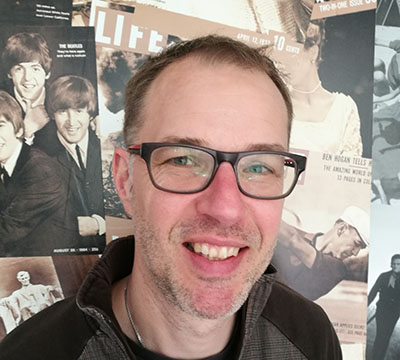
Dr. Bjørn Smit
Bjørn Ivar Smit is senior researcher archaeology at Cultural heritage Agency of the Netherlands. He studied and obtained his PhD at the Institute of Archaeology at the University of Groningen and has worked for one of the larger archaeological companies (RAAP Archaeological Consultancy) in the Netherlands. His work at the Cultural Heritage Agency at is directed at the archaeological heritage management in the Netherlands. He focusses on early prehistory, palaeogeography and palaoelandscapes, drowned landscapes, predictive modelling, general heritage management/legislation on- and off shore and the formulation of knowledge strategies for the Cultural Heritage Agency.

Dr. Karen Waugh
Karen Waugh (ⴕ 2019) was co-director of Vestigia Archaeology & Cultural History Ltd. She received a PhD from the University of Durham (UK) in 1999. As a Roman pottery specialist she worked in the United Kingdom, Germany and the Netherlands. From 1995 until 2002 she worked as a project manager Archaeology at the Netherlands Cultural Heritage Agency on the Betuweroute and HSL-Zuid infrastructural projects. From 2002 until 2019 she continued managing large-scale archaeological projects involving Vestigia, Hanzelijn being the most time consuming of these. Karen was also very active in promoting professional standards and international cooperation between archaeologists. In 2017 she was elected secretary of the Executive Board of the European Association of Archaeologists, a position see fulfilled until her untimely death in the summer of 2019.
Abstract:
The Netherlands are internationally renowned for the archaeology of its wetland environments. The reclamation of the Flevoland Polders in the early half of the 20th century not only exposed hundreds of shipwrecks, but also remnants of prehistoric landscapes and traces of human occupation dating to Mesolithic and Neolithic times. Ultimately, this led to the ‘discovery’ of the Swifterbant Culture in the 1960s-1970s, and which was initially seen as a Dutch equivalent of the Ertebølle Culture.
Archaeological investigations conducted by the University of Groningen, and later also the University of Amsterdam, delivered important new data on the nature of the Swifterbant Culture. It became key in the discussion about the adoption of crop cultivation and animal husbandry by hunter-gatherers living in wetland environments. Also, the Swifterbant Culture became central in the debate on the meaning of archaeologically defined ‘cultures’, questioning relationships between social interaction and material culture. With the increase of urbanisation and infrastructural works, alongside changes in the Dutch Monuments Act, dozens of small and large-scale development-led investigations got initiated at the turn of the century.
One project involved the construction of the Hanzelijn railway, crossing one of the polders from West to East. Archaeologists became aware that much of what was known – and unknown – about the prehistoric past of the Flevoland Polders, was not easily accessible. It was therefore decided to bring together, as much as possible, all the information from the many scattered sources, and make it accessible to professionals, both inside and outside the Netherlands. The result is this book, which presents an overview of the most important sites and data, and what these learn us about the nature of the archaeological record, landscape change, prehistoric subsistence, ritual behaviour, as well as socio-cultural developments during the Mesolithic and Neolithic.
Previously considered an impossibility, ‘fossilised’ fields, discovered at Swifterbant, demonstrate crop cultivation in wetland environments in an early stage of the Neolithic. In fact, the prehistory of the Flevoland Polders is tightly connected to the dynamic nature of the extended wetlands that characterised the landscape since the end of the last glacial. Although often regarded as the ‘margin’ of cultural dynamics in the past, we can now see that the Flevoland Polders were right in the centre of fundamental long-term changes in human existence in NW Europe.
Contents
Chapter 1 Introduction of the Hanzelijn Archaeological Project (K. E. Waugh (Ɨ), W. Hessing & J. Flamman)
1.1 Organisation
1.2 The archaeological project
1.3 Knowledge Development Program Archaeology Hanzelijn 2012-2020
1.4 Some retrospective remarks
Chapter 2 The cradle of the Swifterbant culture: 50 years of archaeological investigations in the province of Flevoland (D.C.M Raemaekers & J.H.M. Peeters)
2.1 Introduction
2.2 History of the polders
2.3 Research traditions in the polder
2.4 Research topics and approaches
2.5 The positioning of the Swifterbant Culture
2.6 Archaeology and the public
2.7 Conclusions
Chapter 3 Hidden landscapes: mapping and evaluating deeply buried remains of human activity (J.H.M. Peeters & B.I. Smit)
3.1 Introduction
3.2 Climate, sea level rise and the structure of the subsurface
3.3 The character and quality of archaeological remains
3.4 Mapping hidden landscape units
3.5 The identification of sites: on statistics and indicators
3.6 Excavations: windows on the past
3.7 Conclusions
Chapter 4 Exploiting a changing landscape: subsistence, habitation and skills (J.H.M. Peeters, T. ten Anscher, L.I. Kooistra, L. Kubiak-Martens & J. Zeiler)
4.1 Introduction
4.2 Taphonomy and analysis: the representativeness and interpretive value of find assemblages
4.3 Wild and domesticated mammals as sources of food
4.4 Fishing in a drowning landscape
4.5 Birds in the diet
4.6 Plant resources in the food economy
4.7 Food preparation and consumption
4.8 Resources and technology
4.9 Habitation patterns
4.10 Conclusions
Chapter 5 People, ritual and meaning (D.C.M Raemaekers)
5.1 Introduction
5.2 Burial practice
5.3 Other cultural practices with human bones
5.4 Depositions
5.5 Materiality
5.6 Conclusions
Chapter 6 From land to water: geomorphological, hydrological and ecological developments in Flevoland from the Late Glacial to the end of the Subboreal (L.I. Kooistra & J.H.M. Peeters )
6.1 Introduction
6.2 Study of the history of the Flevoland landscape in broad outline
6.3 Landscape dynamics in Flevoland
6.4 A new view of the landscape
6.5 Three windows of observation
6.6 Conclusions
Chapter 7 Transformations in a forager and farmer landscape: a cultural biography of prehistoric Flevoland (J.H.M. Peeters, L.I. Kooistra & D.C.M. Raemaekers)
7.1 Introduction
7.2 The landscape as a source of subsistence
7.3 Cultural structuration of the environment
7.4 Socio-cultural cohesion
7.5 Conclusions
Site Atlas: Windows of observation: the quality, nature and context of excavated sites in Flevoland (T.Hamburg & B.I. Smit)
I.1Introduction
I.2 Zuidelijke Flevoland
I.2.1 Almere – Hoge Vaart/A27
I.2.2 Almere – Europakwartier site 7
I.2.3 Almere – Zwaanpad
I.2.4 Zeewolde – Oz35/Oz36
I.3 Oostelijk Flevoland
I.3.1 Dronten N23/N307 – site 5
I.3.2 Hanzelijn – Area VIII
I.3.3 Hanzelijn – Tunnel Drontermeer (area XVI)
I.3.4 Swifterbantcluster
I.4 Noordoostpolder
I.4.1 Emmeloord J97
I.4.2 Schokkerhaven – E170
I.4.3 Schokland P14
I.4.4 Urk – E4
Bibliography

Dr. Hans Peeters
Hans Peeters is associate professor at the Groningen Institute of Archaeology, University of Groningen. He obtained his PhD from the University of Amsterdam. As a specialist in the archaeology of hunter-gatherers and early farmers, he worked at the Dutch Cultural Heritage Agency from 1997 till 2009, and was involved in various projects, notably in Flevoland. In his work, he focusses on the relationship between landscape dynamics and hunter-gatherer behaviour.

Dr. Laura Kooistra
Laura Immy Kooistra is senior researcher archaeobotany and one of the founders of BIAX Consult, Biological Archaeology & Environmental Reconstruction. She studied biology at the Leiden University where she was educated in palaeoetnobotany and palynology. In 1996 she obtained her PhD with the thesis Borderland Farming. Possibilities and limitations of farming in the Roman Period and Early Middle Ages between Rhine and Meuse. Besides business as usual she is interested in subjects concerning the history and development of the environment, and the use of it by hunter-gatherers and farmers from prehistoric times till the early middle ages in the Netherlands. Another main issue is the provenance of food for the Roman army in the Rhine delta.

Prof. Dr. Daan Raemaekers
Daan Raemaekers is full professor of archaeology of northwestern Europe at the Groningen Institute of Archaeology, University of Groningen. He obtained his PhD on the role of the Swifterbant culture in the transition to farming in northwestern Europe from Leiden University in 1999. In the period 1998-2002, he worked as project manager at RAAP Archaeological Consultancy and was involved in numerous developer-led projects in the province of Flevoland. He was appointed full professor at the University of Groningen in 2002.

Dr. Bjørn Smit
Bjørn Ivar Smit is senior researcher archaeology at Cultural heritage Agency of the Netherlands. He studied and obtained his PhD at the Institute of Archaeology at the University of Groningen and has worked for one of the larger archaeological companies (RAAP Archaeological Consultancy) in the Netherlands. His work at the Cultural Heritage Agency at is directed at the archaeological heritage management in the Netherlands. He focusses on early prehistory, palaeogeography and palaoelandscapes, drowned landscapes, predictive modelling, general heritage management/legislation on- and off shore and the formulation of knowledge strategies for the Cultural Heritage Agency.

Dr. Karen Waugh
Karen Waugh (ⴕ 2019) was co-director of Vestigia Archaeology & Cultural History Ltd. She received a PhD from the University of Durham (UK) in 1999. As a Roman pottery specialist she worked in the United Kingdom, Germany and the Netherlands. From 1995 until 2002 she worked as a project manager Archaeology at the Netherlands Cultural Heritage Agency on the Betuweroute and HSL-Zuid infrastructural projects. From 2002 until 2019 she continued managing large-scale archaeological projects involving Vestigia, Hanzelijn being the most time consuming of these. Karen was also very active in promoting professional standards and international cooperation between archaeologists. In 2017 she was elected secretary of the Executive Board of the European Association of Archaeologists, a position see fulfilled until her untimely death in the summer of 2019.
- Digital & Online access
-
Buy via Sidestone (EU & UK)
-
Buy via our Distributors (WORLD)
For non-EU or UK destinations you can buy our books via our international distributors. Although prices may vary this will ensure speedy delivery and reduction in shipping costs or import tax. But you can also order with us directly via the module above.
UK international distributor
USA international distributor
- Browse all books by subject
-
Search all books

We will plant a tree for each order containing a paperback or hardback book via OneTreePlanted.org.
You might also like:
© 2025 Sidestone Press KvK nr. 28114891 Privacy policy Sidestone Newsletter Terms and Conditions (Dutch)
